Sri Lankan president Rajapaksa’s resignation accepted, parliament to vote replacement next week
Sri Lanka may have a new president as early as next week after the unorthodox resignation of embattled President Gotabaya Rajapaksa was accepted.
World
Don't miss out on the headlines from World. Followed categories will be added to My News.
Sri Lanka’s parliament will vote on a new president on Wednesday, the speaker’s office said on Friday following the resignation of Gotabaya Rajapaksa after he was driven out of the country.
Nominations for the post of president will be received on Tuesday and MPs are due to vote the following day, Speaker Mahinda Yapa Abeywardana’s office said in a brief statement.
Sri Lanka’s Prime Minister Ranil Wickremesinghe was sworn in on Friday as acting president, his office said, replacing Mr Rajapaksa who fled to Singapore following months of protest against him.
Mr Wickremesinghe, 73, took his oath of office before chief justice Jayantha Jayasuriya, Mr Wickremesinghe’s office said in a brief statement.
It comes after the resignation of Sri Lanka’s president Gotabaya Rajapaksa was accepted, the crisis-hit country’s parliamentary speaker announced earlier on Friday.
The formal declaration makes Gotabaya Rajapaksa – once known as ‘The Terminator’ for his ruthless crushing of Tamil rebels – the first Sri Lankan head of state to resign since it adopted an executive presidency in 1978.
He emailed in his resignation from Singapore after flying to the city-state from the Maldives, where he initially escaped after demonstrators overran his palace at the weekend.
“Gotabaya has legally resigned” with effect from Thursday, speaker Mahinda Yapa Abeywardana told reporters.
“I have accepted the resignation.”
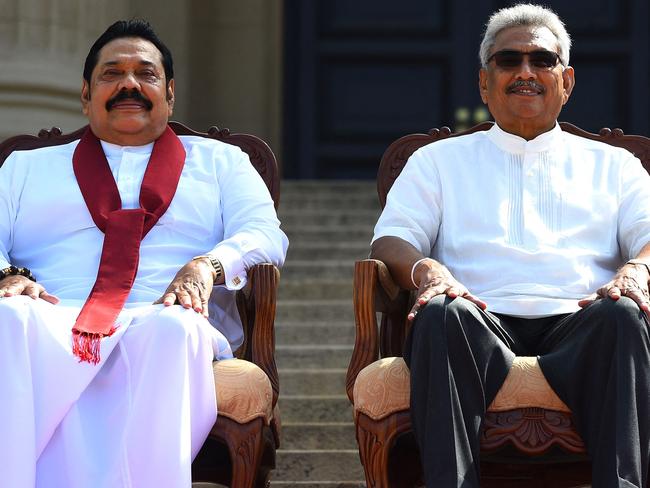
Under Sri Lanka’s constitution, Prime Minister Ranil Wickremesinghe – whose departure is also being demanded by protesters – will automatically become acting president until parliament can elect an MP to succeed Rajapaksa for the rest of his term.
The legislature will be summoned on Saturday, Abeywardana told reporters at his residence, adding he hoped to complete the election process “within seven days”.
The failure of the prime minister to immediately resign following his flight from Sri Lanka caused considerable concern in the country.
Anti-government demonstrators had vowed to press on with their bid to bring down the president and prime minister in the face of a dire economic crisis.
Protesters overran the President’s palace at the weekend, forcing him to flee to the Maldives on Wednesday, when activists also stormed the office of Prime Minister Ranil Wickremesinghe.
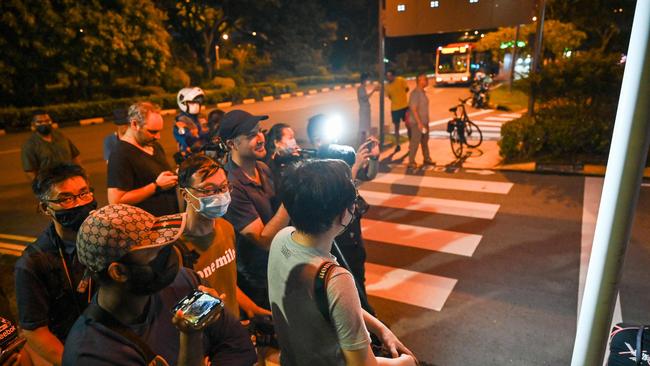
Rajapaksa had promised to resign on Wednesday, but there was no announcement he had done so.
The premier, whom Rajapaksa named as acting president in his absence, had demanded the evacuation of state buildings and instructed security forces to do “what is necessary to restore order”.
“We are peacefully withdrawing from the Presidential Palace, the Presidential Secretariat and the Prime Minister’s Office with immediate effect, but will continue our struggle,” a spokeswoman for the protesters said.
A top Buddhist monk supporting the campaign had earlier called for the more than 200-years-old presidential palace to be handed back to authorities and ensure its valuable art and artefacts were preserved.
“This building is a national treasure and it should be protected,” monk Omalpe Sobitha told reporters.
“There must be a proper audit and the property given back to the state.”

Hundreds of thousands have visited the compound since it was opened out to the public after Rajapaksa fled and his security guards backed down.
In a televised address after thousands of people captured his office in Colombo, Wickremesinghe declared: “Those who go to my office want to stop me from discharging my responsibilities as acting president.
“We can’t allow fascists to take over. That is why I declared a nationwide emergency and a curfew,” he added.
The curfew was lifted at dawn on Thursday, but police said a soldier and a constable were injured in overnight clashes with protesters outside the national parliament.
The attempt on the legislature was beaten back, unlike at other locations where the protesters had spectacular success.
The main hospital in Colombo said about 85 people were admitted with injuries on Wednesday, with one man suffocating to death after being tear-gassed at the premier’s office.
TROOPS GIVE IN TO PROTESTERS
Sri Lankan troops stood with their weapons lowered in the grounds of the prime minister’s office on Wednesday, doing nothing to halt the huge mass of people wandering through the compound, despite orders to “restore order”.
Some of the civilians sang or waved the Sri Lankan flag, with its motif of a golden lion brandishing a sword, after they lobbed back tear gas canisters and pushed past elite commandos on Wednesday to occupy the premises in the capital Colombo.
Thousands of people cheered as they breached the walls of the colonial-era compound on a leafy boulevard, opening yet another symbol of state power to the public.
#SriLanka:We call on all sides to refrain from violence & ensure peaceful political transition. A broad+inclusive process respecting rule of law is needed. Leaders must call for respect of life+property. Security forces incl military must respect human rights & exercise restraint pic.twitter.com/N2vmsDbZa8
— UN Human Rights (@UNHumanRights) July 13, 2022
The office was the fourth government building occupied by protesters in as many days, following the seizure of the president’s seafront office and the official residences of Sri Lanka’s two most senior elected officials.
And as with those earlier conquests, by evening the compound had been repurposed into a public attraction, with demonstrators who helped storm the building hours earlier now chaperoning others through its rooms.
“We feel proud,” said Satish Bee, a businessman who came to explore the compound once the dust had settled.
“There’s no proper governance in this country. It has never been good … The youngsters, they don’t want to continue like this.”

The United Nations Human Rights office called on all sides of the political crisis in Sri Lanka “to refrain from violence” to ensure a “peaceful political transition” in a tweet on Wednesday.
“Leaders must call for respect of life+property. Security forces inch military must respect human rights & exercise restraint,” the tweet read.
Guards abandoned a losing battle to halt the crowd’s advance less than two hours after the building’s usual occupant, Prime Minister Ranil Wickremesinghe, was declared Sri Lanka’s acting head of state by incumbent Gotabaya Rajapaksa.
Wickremesinghe declared a nationwide state of emergency and soon appeared on television to warn that troops had been instructed to do “what is necessary” to return the building to government control.
He also officially imposed a night curfew until 5am local time on Thursday, according to an official ordinance.
Before his official appointment as acting president, Wickremesinghe had tried to impose a curfew but later retracted the order.
According to the ordinance, “no person shall be on any public road, railway, public park, public recreation ground or other public ground or the seashore in such areas, from 12.00 hour of July 13th, 2022 to 05.00 hour of July 14th, 2022.”
But on the ground, his words went unheeded.

‘WE ARE NOT TERRORISTS’
People began mobbing the office in the morning, after news spread through the capital that Rajapaksa – blamed by many for driving the country to economic ruin – had left the island nation on a military aircraft bound for the Maldives in the early hours.
What followed was an object lesson in patience and strategy from a crowd hardened by earlier confrontations with security forces over months of protests.
Some carried red traffic cones to smother and safely extinguish tear gas rounds periodically fired into the street by guards stationed along the walls.
Others guided friends or strangers blinded by the smoke to safety behind the cover of a wall, helping to flush their eyes with fluid.
Bolder members of the crowd peeled off a part of the gate and sections of wrought iron fence, prompting fresh barrages of tear gas – and loud cheers when still-smouldering canisters were thrown back at the troops that fired them.
In his televised statement, PM Wickremesinghe made allusions to “fascists” trying to “take over”.
Dhaniz Ali, one of those walking through the compound after it was occupied, told AFP that protesters would continue to find new government buildings to occupy.
“We are not terrorists,” he said. “We are just Sri Lankan citizens here to save the country.”
ANGRY PROTESTERS TAKE OVER SRI LANKAN TV STATION
Anti-government protesters broke into Sri Lanka’s main state television station on Wednesday and briefly took over broadcasts, footage showed.
An unidentified man barged into the studio of Rupavahini network during a live program and ordered that only protest-related news should be broadcast. The transmission was cut off and replaced with a recorded program.
Bhasura Wickremesinghe, a 24-year-old student of maritime electrical engineering, who came with friends, told The Times of India the president fleeing the country was a “timid act”.
“I’m not celebrating. There’s no point celebrating. We have nothing in this country at the moment.”
Meanwhile, thousands of anti-government protesters stormed into Sri Lanka Prime Minister Ranil Wickremesinghe’s office Wednesday, hours after he was named as acting president.
Men and women breached military defences and entered the premier’s office to raise national flags, witnesses told AFP.
Police and troops failed to hold back crowds despite firing tear gas and water cannons at them.
Wickremesinghe, in a televised address, said he had instructed security forces to restore order, but troops were seen backing down at his office leaving gates open for protesters to stroll in.
“I have ordered military commanders and the police chief to do what is necessary to restore order,” Wickremesinghe said.
“Those who stormed into my office want to stop me from discharging my responsibilities as acting president.” His private home was set ablaze on Saturday after protesters captured the president’s office and home on Saturday.
“We can’t tear up our constitution. We can’t allow fascists to take over. We must end this fascist threat to democracy,” he said adding that the state buildings occupied by protesters must be returned to state custody.
The protesters’ actions were a repeat of Saturday’s capture of President Gotabaya Rajapaksa’s home and office, which forced him to eventually flee the country earlier Wednesday.
END FOR TERMINATOR
Known as “The Terminator” to family and foes alike for his ruthless crushing of Tamil rebels to end a decades-long civil war, Sri Lankan President Gotabaya Rajapaksa’s rule is drawing to a close with him a fugitive and his island’s economy in ruins.
Rajapaksa, one of a clan of four brothers who have dominated the country’s politics in recent years, was defence secretary under his brother Mahinda’s Rajapaksa’s presidency from 2005-15.
He denied allegations that at least 40,000 minority Tamil civilians were killed by troops under his command during the closing months of the war, but the accusations bolstered his tough-guy image in the eyes of the majority Sinhalese.
He was also considered the architect of “white van” abductions under Mahinda, when dissidents and journalists were grabbed in unmarked vehicles and disappeared, allegedly the victims of extrajudicial killings.
He made no bones about winning the 2019 elections with the overwhelming support of his own majority Sinhala-Buddhist community.
For Sri Lanka’s influential Buddhist clergy, he was the reincarnation of Sinhalese warrior king Dutugemunu the Great, who is known for vanquishing a Tamil ruler.
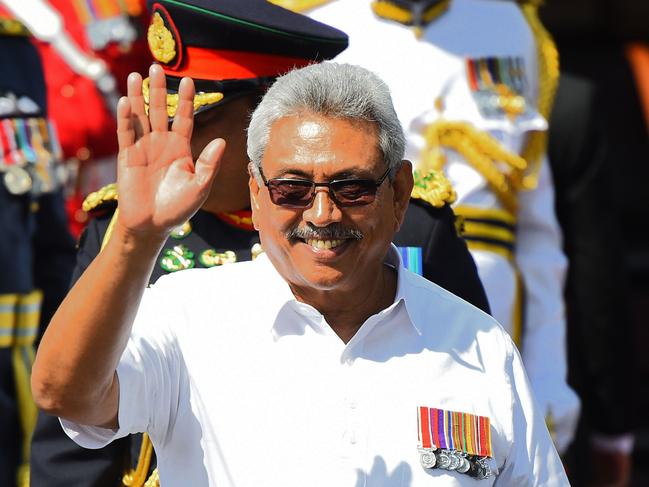
Dutugemunu reigned for 24 years, but Rajapaksa fled less than three years into his rule – and a resignation would make him Sri Lanka’s shortest-lived directly elected president.
Sri Lanka’s speaker of the parliament said Rajapaksa confirmed his resignation over the phone on Wednesday, but that he is still waiting for the official document confirming it.
“With regards to an official document signifying it, I was told that it would reach me within the day today,” Speaker Mahinda Yapa Abeywardena said during a televised briefing.
Rajapaksa was due to formally resign on Wednesday after being forced to step down in the wake of months-long protests over the nation’s crippling economic crisis.
The 73-year-old leader flew to the neighbouring Maldives on Wednesday, four days after his presidency crumbled and tens of thousands of protesters overran his official residence.
That came after months of demonstrations demanding his resignation over an economic crisis, triggered by the coronavirus pandemic but exacerbated by mismanagement.
The former soldier marketed his lack of political expertise as a virtue but Tamil legislator Dharmalingam Sithadthan said what Rajapaksa projected as his strength was actually his weakness.
“His lack of political knowledge showed in the way he worked,” Sithadthan told AFP. “He flip-flopped from one crisis to another. He thought by simply issuing orders things would materialise.
“Every time I met with him, he would say he is focused on the economy and law-and-order, but he failed in both.”
On Monday, Rajapaksa was flown to an air base near the main international airport, raising speculation he will escape into exile abroad.
He fled the presidential palace in Colombo under naval protection on Saturday, shortly before tens of thousands of protesters overran the compound.
Hours later, the parliamentary speaker announced Rajapaksa would resign on Wednesday to allow a “peaceful transition of power”.
Rajapaksa had taken refuge at a navy facility in the island’s northeast, a top defence official said, adding that he was brought to the Katunayake air base adjoining the country’s main international airport.
“He and his entourage were flown back to Colombo in two Bell 412 choppers,” the official added.
There was no official word from the president’s office about his whereabouts, and several local media reports speculated he was set to leave for Dubai later Monday.
But four commercial flights subsequently took off for Middle Eastern destinations without him, airport officials said.
Immigration officers were refusing to go to the VIP suite to stamp his passport, while he insisted he would not go through the public facilities, they added – a humiliating stand-off for the leader once known as ‘The Terminator’.
A military source said Rajapaksa, who remains the commander-in-chief of the armed forces, had the option of travelling in an air force aircraft.
Prime Minister Ranil Wickremesinghe’s office said Rajapaksa had officially informed him of the president’s intention to resign, without specifying a date.
WILD SCENES AFTER TAKEOVER OF PRESIDENTIAL PALACE
Sri Lankan protesters refused to budge from President Gotabaya Rajapaksa’s residence on Sunday, a day after they stormed his home, forcing him to flee with the navy and announce he would resign.
“Our struggle is not over,” student leader Lahiru Weerasekara told reporters the day after Rajapaksa, currently taking refuge on a vessel offshore, said he would step down on Wednesday.
“We won’t give up this struggle until he actually leaves.”
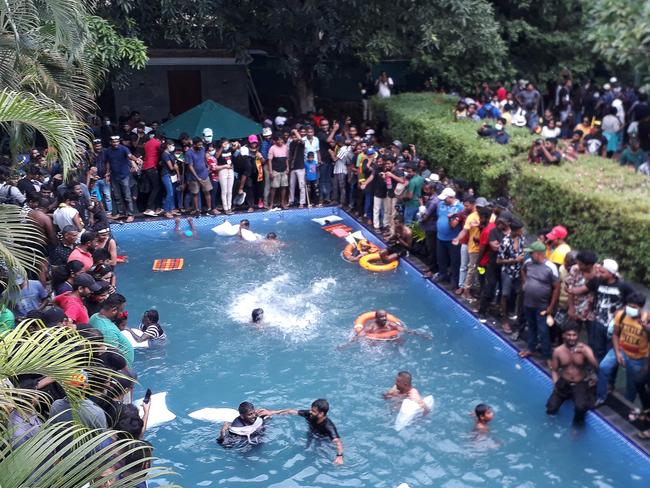
The dramatic events on Saturday were the culmination of months of protests by people enraged by the South Asian island nation’s unprecedented economic crisis and the Rajapaksa clan’s incompetence and corruption.
Hundreds of thousands massed in Colombo demanding Rajapaksa take responsibility for shortages of medicines, food and fuel that have brought the once-relatively rich economy to its knees and caused misery for ordinary people.

After storming the gates of the colonial-era presidential palace, protesters lounged in its opulent rooms, somersaulting into the compound’s pool and rummaging through Rajapaksa’s clothes.
At a clock tower near the palace, activists hung an effigy of Rajapaksa on Sunday evening as thousands of onlookers cheered.
The streets leading to the palace were choked with people, some carrying toddlers and wheeling along the elderly.
Troops had fired in the air to help Rajapaksa escape on Saturday. The president then boarded a naval craft which steamed to the safety of the island’s southern waters.
On Sunday the presidential palace was a free-for-all, with children and parents plonking on a grand piano, admiring the expensive artwork, picnicking and taking it in turns to sit in the president’s chair.
“When leaders live in such luxury, they have no idea how the commoners manage,” Buddhist monk Sri Sumeda told AFP.
“This shows what can be done when people decide to exercise their power.” Rajapaksa’s nearby seafront office was also overrun on Saturday, and Prime Minister Ranil Wickremesinghe’s residence was set on fire even after he too offered to resign.
Police said they arrested three men in connection with the arson attack at the premier’s home.

WASHINGTON REACTS
Washington urged Sri Lankan leaders to act quickly to address the situation “with a commitment to the betterment of the nation – not any one political party”.
US Secretary of State Antony Blinken said on Sunday that Russia’s restrictions on Ukrainian grain exports and the resulting rise in prices “may have contributed” to Sri Lanka’s economic turmoil.
The European Union urged “all parties to co-operate and focus on a peaceful, democratic and orderly transition”.

On Sunday it was unclear who, if anyone, would be able to garner enough support among politicians to succeed Rajapaksa.
“We are heading for dangerous uncertainty,” minority Tamil legislator Dharmalingam Sithadthan told AFP.
“Gota should have resigned immediately without leaving a power vacuum.”
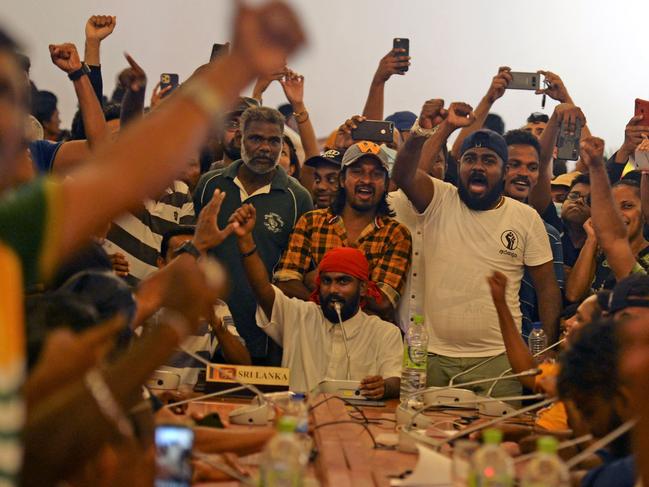
The bankrupt government has defaulted on its $51 billion external debt and is seeking an International Monetary Fund bailout.
The IMF said Sunday that it hopes for “a resolution of the current situation that will allow for resumption of our dialogue”.




